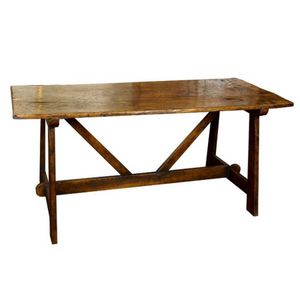George III Oak Bench with Baluster Supports
A George III oak bench, the plank top on angled baluster supports, joined by a stretcher, height 46 cm, length 172 cm, width 32 cm
You must be a subscriber, and be logged in to view price and dealer details.
Subscribe Now to view actual auction price for this item
When you subscribe, you have the option of setting the currency in which to display prices to $Au, $US, $NZ or Stg.
This item has been sold, and the description, image and price are for reference purposes only.
- George Iii - George III (1738 - 1820) was King of Great Britain and Ireland from 1760 to 1820.
- Baluster (furniture) - An architectural term for a column in a balustrade or staircase, often defined as a "vase shape". The shape is extensively used in furniture and decorative arts.
In furniture, it is used to describe a chair or table leg turned in that form, or more usually as an inverted baluster, with the bulbous section to the top. Less commonly used to describe a chair back that has the outline of a baluster. A baluster may also be split and applied to the front of a cupboard for ornamentation.
For ceramics and silver items it is often used to describe the shape of the whole item, rather than a part.
In Georgian glassware, the shape is commonly seen in the stem of glasses. - Oak - Native to Europe and England, oak has been used for joinery, furniture and building since the beginning of the medieval civilisation. It is a pale yellow in colour when freshly cut and darkens with age to a mid brown colour.
Oak as a furniture timber was superceded by walnut in the 17th century, and in the 18th century by mahogany,
Semi-fossilised bog oak is black in colour, and is found in peat bogs where the trees have fallen and been preserved from decay by the bog. It is used for jewellery and small carved trinkets.
Pollard oak is taken from an oak that has been regularly pollarded, that is the upper branches have been removed at the top of the trunk, result that new branches would appear, and over time the top would become ball-like. . When harvested and sawn, the timber displays a continuous surface of knotty circles. The timber was scarce and expensive and was used in more expensive pieces of furniture in the Regency and Victorian periods. - Stretcher - A horizontal rail which connects the legs of stools, chairs, tables and stands, to provide stabilisation of the legs. A stretcher table is any table with a stretcher base. The term is usually applied to substantial farmhouse tables, although many cabinetmaker's pieces, such as sofa tables, also have turned stretchers.
This item has been included into following indexes:
Visually similar items

A Cromwellian oak refectory table, English, dated 1656. 76 cm high, 270 cm wide, 81 cm deep
Sold by
in
for
You can display prices in $Au, $US, $NZ or Stg.

French Elmwood farm table, c. 1850, with exposed mortise and tenons. Height 79 cm, width 79 cm, length 169 cm
Sold by
in
for
You can display prices in $Au, $US, $NZ or Stg.

Three rustic wooden Benches, largest 214 cm long (3)
Sold by
in
for
You can display prices in $Au, $US, $NZ or Stg.

English oak bobbin leg occasional table with peg joints, 18th century. 72 cm high, 92 cm wide, 59 cm deep.
Sold by
in
for
You can display prices in $Au, $US, $NZ or Stg.
